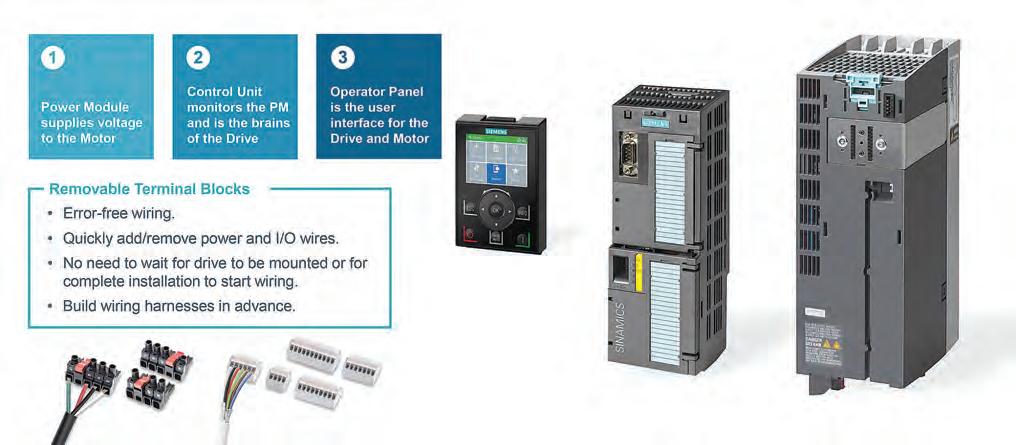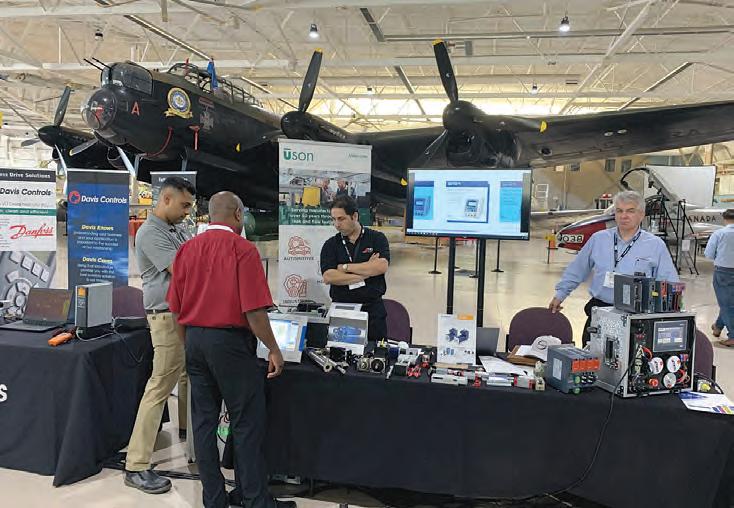
5 minute read
Decentralizing the Drive
from DES OCT 2022
How modular drive technology simplifies setup, reduces cost and speeds time-to-market.
There are two types of drive configurations on the market today, namely centralized and decentralized. A centralized drive is characterized by mounting the drives and power distribution hardware within an enclosure and running cable lead lengths from the enclosure to the line or field devices being controlled.
In the decentralized approach, the drive is placed out on the machine or assembly line. The main benefit is that heat is removed from the electrical enclosure, resulting in considerable cost savings in machine or line build time.
A basic modular drive consists of a power module, control unit and an operator panel. The power module supplies voltage to the motor, while the control unit monitors the power module and is the brains of the drive. The operator panel is the user interface for the drive and motor control. OEMs can prewire the drives before panel builders mount the equipment, reducing time-to-market.
The power module also saves space as a result of having the same frame size, with or without an integrated filter. Integrated energy recovery enables excess energy to be regenerated to the line supply, which eliminates the need for breaking resistors. Sideby-side mounting saves space in the control cabinet and reduces costs without de-rating.
Regenerative power modules on the drive can help take the excess energy and apply it back to the grid or even redirect it into the plant to power other equipment. While regen power has been a viable concept for decades, today it can be applied to a much lower power range of motors.
In addition, using the concept with variable speed drives means the applications broaden considerably, from simple on/off pumps or motors to many types of process equipment that fluctuate greatly in their power demands.
The operator panel on today’s advanced modular drives features simple setup and configuration using wizards with integrated plain text help functions. In addition, the panel includes quick access to all parameters and displays fault codes without scrolling. The fault will provide a user with a description and reason for the fault, as well as a remedy appearing in the Smart Access Module (SAM) as a Wi-Fi hotspot and a web interface built into the module. This SAM is also ideal for configuring drives within a mobile device or laptop.
For those who still want a centralized drive design, they can benefit from the use of push-through design (i.e. hanging the drive’s heat sync outside the enclosure). As a result, the AC unit can be sized for the control unit heat watt loss or circulating fans can replace AC units. The advantages include a lower
energy bill up to 50%, a smaller shop floor footprint and a lower cost for AC unit maintenance. As a general rule, every 10°C increase in temperature reduces product life by half.
All popular drives from major manufacturers today use common parameters, though some are more beneficial, owing to their integration of this feature with other design and electrical characteristics. This makes it easier to program and remember settings and locations for the operators and maintenance personnel.
In addition, common parameters make users less reliant on user manuals. Once applied to one drive, the same procedure applies to most others in the system. Drives such as the SINAMICS line from Siemens also include predictive maintenance capability, which gives users alert warnings before service is needed. Furthermore, the most advanced drives have safety features built-in such as safe brake control, safe torque off and safe stop 1. These features are available in hardwire versions and on a network basis.
Drive investment can also be a gateway to digitalization, in that installation and running of today’s machines can be simulated virtually. These “digital twin” technologies approximate “real world” conditions by factoring in all component functions as well as machine kinematics into the calculations. The savings occur at both ends of the design/build scenario, as a result. Faster time-to-market combines with faster commissioning, startup and reduced time to first quality product.

Contemporary decentralized drive systems combine a power module, control unit and IO panel working in unison.
Motor Controls
There are three different types of motor controls in popular use today, of which the across-the-line type is very reliable and has the lowest initial investment cost. Essentially, the full voltage and current are applied at the time of engagement (up to 600%) and the motor runs at nameplate speed. In the middle price range, soft start provides the ability to control current, acceleration and deceleration. As with across-the-line, the motor will run at nameplate speed.
Variable frequency drives (VFDs) are the most expensive in their initial investment but offer many advantages. These include the ability to control speed at any set point, to control current and torque throughout the entire speed range and to realize energy savings through regenerative braking.
VFDs are an attractive option due to the fact they reduce mechanical and electrical stress on systems, control process variables, reduce in-rush current, enable energy reduction and provide connectivity, with full data analytics.
Conventional full voltage starting can cause mechanical shock since it can’t control the acceleration and deceleration rates of a machine, nor the speed of the machine. Furthermore, full voltage starting can’t control the in-rush current that the motor draws when it starts and typically allows 600% of the rated motor current during start-up. As a result, the in-rush can cause voltage dips and other power disturbances.
Variable frequency drives connect easily to offsite programming portals and can offer Ethernet and Profinet connectivity for running additions to a brownfield installation, as another example. Drives are also being integrated into virtual systems and cloud databases. These are perhaps hidden but very real cost saving potentials for a machine builder or end user. Careful consideration should be given to such factors, when developing a new machine or retrofit plan.
Depending on the application, a variable torque or a constant torque inverter is used. The torque needed to perform a function increases as the speed increases in variable torque. Constant torque, as the name implies, means that torque remains the same as power increases. Variable torque is applied to pumps and fans, while constant torque applies to everything else. In centrifugal applications, like pumps and fans, a reduction in speed results in a proportional reduction in flow. The affinity laws and incremental power reduction rules apply here, whether in an air or fluid flow system.
OEMs must be able to build machines as cost effectively as possible to win orders today. They must be able to articulate the value of the machine design over the competition and they must build a machine that holds up to the customers’ demands with provable energy savings and other performance benchmarks that lower the TCO. The drives can play a significant role in this process. Being cognizant of the options and available features on the market today benefits OEMs and their customers in trackable ways. | DE




